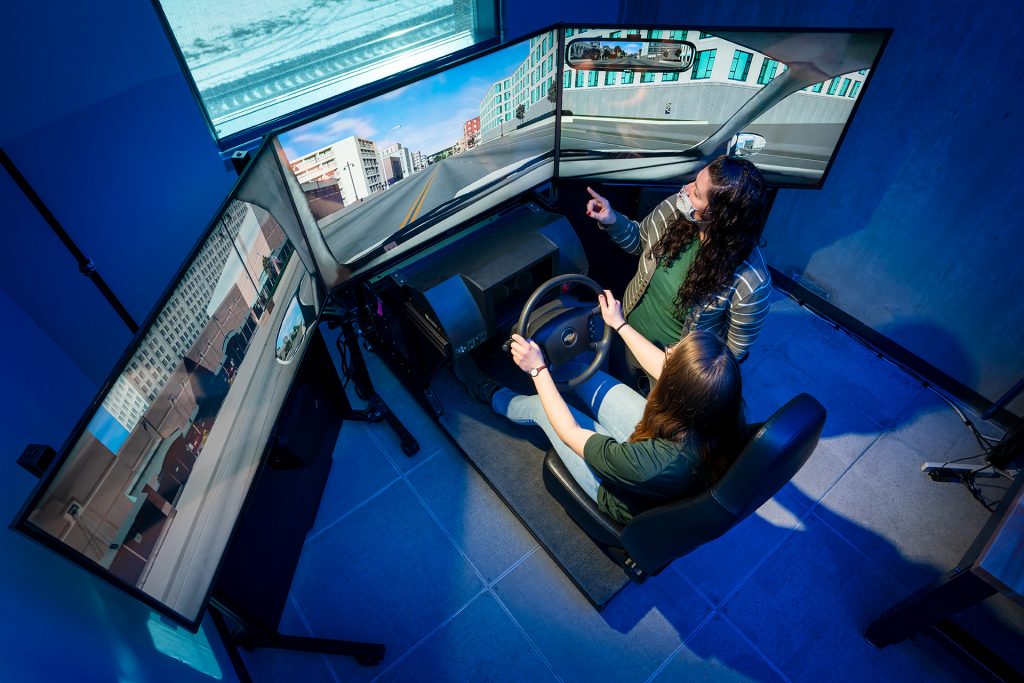
‘Intersection of psychology and engineering design’: A conversation about the importance of human factors in engineering
- By: Katharyn Peterman
 Engineering as a discipline is centered around problem solving. These problems can range widely in complexity and in scale.
Engineering as a discipline is centered around problem solving. These problems can range widely in complexity and in scale.
Systems engineers will often look at these problems through the lens of both systems thinking and human factors to ensure a robust solution.
Researching and improving human-system interfaces drives Erika Miller, assistant professor in systems engineering, and Steve Conrad, associate professor in systems engineering, who both research and teach courses related to human factors.
We sat down with Erika and Steve to learn more about human factors and why they believe implementing human factors in all engineering disciplines will lead to more successful designs.
First, what is human factors?
Dr. Erika Miller: Informally, I introduce it as the intersection between psychology and engineering design. More formally, though, human factors helps us to make systems safer, more efficient, and more satisfying for the user.
Dr. Steve Conrad: Human factors is the interplay between systems and the humans that interact with those systems. This can range from where you place light switches to designing human-machine interactions to modeling how humans behave and act.
Both Dr. Miller and I focus on the human behavioral component, trying to understand how humans make decisions and react to different designs. Human factors is very applicable to design because every design element you go after, whether it’s a bridge or electrical circuit, has a human component to it.
How do human factors play a role in other engineering disciplines beyond systems engineering?
EM: Human factors, essentially, can help all engineers design technology to fit the human user, instead of force fitting the human to fit the technology. Safe and efficient systems are crucial, and this can be achieved through human factors, but another important piece is human satisfaction, which is often left out of the design process. If users aren’t enjoying the way they are interacting with a system, they will find their own way to interact with the system and that’s where errors can come in and deviations from the engineered design.
Humans are often unfairly considered the bottleneck or blamed for errors. Regardless of how much automation or technology we implement, humans will still need to operate, use, or somehow interact with the system, and if humans don’t understand how it works, you won’t get the full benefit from the system.
How do each of your research areas tie into human factors?
SC: A lot of what I focus on is water, energy, and climate. For example, I ask questions about how people use or reuse water, what their beliefs are about reused water, and the list goes on. I dive a lot into policy and planning questions with the goal of developing a way to predict behavior.
EM: I focus on transportation, and particularly feedback. What feedback can you give road users, whether it’s a pedestrian or a driver, to make transportation safer and guide them to pick the more efficient and/or sustainable route? A lot of my research tries to answer questions like that. I also research technology adoption to better understand how people adopt, or resist, transportation-related policies.
What classes can a student take in the department if they are interested in human factors?
EM: I teach Human Systems Integration (SYSE 534) which is a broad overview of the various applications where human factors is relevant. I use case studies to introduce students to human factors and hope that one of the case studies will help them see how human factors can apply to their industry. I also incorporate human factors into Systems Data Lifecycle and Visualization (ENGR 580A5) class by teaching the importance of considering how people process information when formatting your technical data.
SC: This Fall, I’ll be teaching Quantitative Behavioral Modeling for Engineers (ENGR 581A6) which will focus on the decision making and cognition elements of human behavior. This course is an introduction to Human Systems Modeling and we will be developing simplistic models of how people make decisions. This course, and my Spring course Engineering Decision Support/Expert Systems (ENGR 520), will be heavily applied courses. We will be applying these modeling skillsets to water, energy, and transportation systems.
What do you wish people knew about human factors?
SC: Simply put: studying and implementing human factors can save lives and improves the efficiency of systems.
EM: So often in transportation you hear about a fatality occurring and it always speaks to me. It’s hard not to think that if one thing had changed in the decision-making process this fatality could have been avoided.
I always challenge my students to think of a system that doesn’t have a human play a role in it at some point. The answer is there is no system that does not at some point have a human element. Human-system interaction is necessary whether it’s the design, the building, the use, the maintenance, or the decommissioning of the system. Engineers need to think of the human factors to ensure that these systems work the way they were intended.



